An Improved Numerical Simulation Method for Rockbolt Fracture and Its Application in Deep Extra-Thick Coal Seam Roadways
Abstract
1. Introduction
2. Design and Validation of the Rockbolt Fracture Program
2.1. The Principle of Tensile Fracture of Rockbolts
2.2. Rockbolt Fracture Program Design
- (1)
- When reaching step i (i = 1, 2, 3, …), we first check whether the calculation has converged. If it has, we end the calculation.
- (2)
- If it has not converged, we enter the rockbolt fracture program, where the following steps are performed:
2.3. Rockbolt Fracture Program Validation
2.3.1. Design of Rockbolt Tension Test
2.3.2. Analysis of Test Results
3. Engineering Simulation Applications
3.1. Engineering Background
3.1.1. Engineering Geology and Original Support
3.1.2. Analysis of Roadway Deformation and Support
3.2. Engineering Simulation Test Design
3.2.1. Support Mechanisms and Parameter Ranges
3.2.2. Support Parameter Test Scheme
3.3. Modeling of the Roadway Surrounding Rock and Support
3.4. Analysis of Simulation Results
3.4.1. Rockbolt Length Optimization
3.4.2. Rockbolt Spacing Optimization
3.4.3. Anchor Cable Length Optimization
3.4.4. Anchor Cable Spacing Optimization
3.4.5. Analysis of the Fracture Position of Rockbolts and Anchor Cables
3.5. Optimized Roadway Support Parameters
4. Field Support Verification
4.1. Field Support and Monitoring Scheme
4.2. Analysis of Monitoring Results
4.3. Analysis of Field Situation
5. Discussion
- (1)
- With regard to rockbolts modeled by cableSELs in FLAC3D, the study by Li et al. [20] achieved their intended fracture but did not specify the exact position of the fracture. The improved method proposed in this paper achieves the fracture of the rockbolt at its position of maximum deformation, addressing this deficiency and enhancing the simulation capability of FLAC3D.
- (2)
- The constitutive relationships of the cableSELs determine that a rockbolt can only bear axial force [33], achieving tensile failure of the rod. Therefore, the improved simulation method is suitable for studying geological conditions where the volume deformation of the supporting rock mass is predominant. Currently, this method has been successfully applied in DECS roadways. The next step is to apply this method to other applicable rock mass types to provide support guidelines.
- (3)
- In practical engineering, the fracture of some rockbolts and anchor cables is not solely due to tension but results from a combination of tension, shear, and bending [46]. The pile structural elements (pileSELs) in FLAC3D can withstand the above-mentioned loads [33], providing a comprehensive reflection of the rockbolt’s stress characteristics. If it is necessary to simulate the fracture of a rod at an exact position under complex forces, one can refer to the ideas of the simulation method in this paper to correspondingly develop the pileSELs.
6. Conclusions
- (1)
- This paper proposes an improved method for rockbolt fracture to address the defect of unclear fracture positions in rockbolts modeled with cableSELs in FLAC3D. This method utilizes the total elongation of the rockbolt’s free segment as the fracture criterion, causing the rod to break at the point of maximum deformation. This method was validated by the rockbolt tensile test, and its simulation results are more realistic.
- (2)
- The optimized support parameters of the roadway roof in DECSs were obtained using the improved simulation method. Simultaneously, the simulation results show that rockbolt and anchor cable fractures occur at the end of the free segment near the anchor head. This indicates that the fracture of the rod is mainly caused by roadway deformation. The support rods used in the field should demonstrate good extensibility.
- (3)
- Field application verified the feasibility of the optimized support parameters. The implementation results show that the maximum roof deformation was 90 mm, which is 37.9% lower than that of the original support, and the forces on the support rods are also within the normal range. This research can provide a reference for roadway support under similar conditions.
Author Contributions
Funding
Data Availability Statement
Conflicts of Interest
References
- Xie, S.R.; Wu, Y.Y.; Chen, D.D.; Liu, R.P.; Han, X.T.; Ye, Q.C. Failure analysis and control technology of intersections of large-scale variable cross-section roadways in deep soft rock. Int. J. Coal Sci. Technol. 2022, 9, 19. [Google Scholar] [CrossRef]
- He, Z.; Xie, Z.Z.; Zhang, N.; Han, C.L.; Xiang, Z.; Yan, G.J.; Qiao, H.X.; Shao, C.Y. Research on spatiotemporal evolution law of surrounding rock fractures and hierarchical collaborative control technology in high-stress soft rock roadway: A case study. Eng. Fail. Anal. 2023, 150, 107366. [Google Scholar] [CrossRef]
- Meng, N.K.; Bai, J.B.; Yoo, C. Failure mechanism and control technology of deep soft-rock roadways: Numerical simulation and field study. Undergr. Space 2023, 12, 1–17. [Google Scholar] [CrossRef]
- Li, H.B.; Pan, W.P.; Hua, X.Z.; Luan, B.; Huang, Z.J. Instability characteristics of surrounding rock and surrounding rock control technology of deep coal roadway crossing the fault: A case study of Zhuxianzhuang coal mine. Geomat. Nat. Hazards Risk 2024, 15, 2366376. [Google Scholar] [CrossRef]
- Kang, H.P.; Gao, F.Q.; Xu, G.; Ren, H.W. Mechanical behaviors of coal measures and ground control technologies for China’s deep coal mines—A review. J. Rock Mech. Geotech. Eng. 2023, 15, 37–65. [Google Scholar] [CrossRef]
- Lian, X.Y.; Li, C.; Li, J.; Wu, L. Law of strata pressure behavior of surrounding rock in nearby goaf roadway for extra-thick coal seams of Datong mine area. Front. Earth Sci. 2023, 10, 1015378. [Google Scholar] [CrossRef]
- Zuo, J.P.; Liu, H.Y.; Liu, D.J.; Zhu, F.; Zhao, W.P.; Zhang, Q.; Li, J.H. Theoretical analysis and numerical simulation on the coupled support technology of concrete-filled steel tube and bolt-cable in deep roadway. J. Cent. South Univ. 2023, 30, 257–275. [Google Scholar] [CrossRef]
- Kent, L.; Lightfoot, N.; Jonathan, B.; Crisu, T.; Walker, S. UK experience and numerical modelling for planning and supporting deep longwall over-mining operations. In Proceedings of the 35th International Conference on Ground Control in Mining, Morgantown, WV, USA, 26–28 July 2016; pp. 67–69. [Google Scholar]
- Wu, C.J.; Qin, T.; Wang, L.; Liu, Z. Research on Surrounding Rock Control Technology of Dongbaowei Deep Mining Roadway. Adv. Civ. Eng. 2021, 2021, 6660989. [Google Scholar] [CrossRef]
- He, M.C.; Li, C.; Gong, W.L.; Sousa, L.R.; Li, S.R. Dynamic tests for a Constant-Resistance-Large-Deformation bolt using a modified SHTB system. Tunn. Undergr. Space Technol. 2017, 64, 103–116. [Google Scholar] [CrossRef]
- Yan, H.; He, F.L.; Li, L.Y.; Feng, R.M.; Xing, P.F. Control mechanism of a cable truss system for stability of roadways within thick coal seams. J. Cent. South Univ. 2017, 24, 1098–1110. [Google Scholar] [CrossRef]
- Kang, H.; Wu, Y.; Gao, F.; Lin, J.; Jiang, P. Fracture characteristics in rock bolts in underground coal mine roadways. Int. J. Rock Mech. Min. Sci. 2013, 62, 105–112. [Google Scholar] [CrossRef]
- Wen, J.L.; Jiang, F.X.; Liu, J.H.; Yin, Y.M.; Zhang, Y.C. A study on the fracture control of rock bolts in high ground pressure roadways of deep mines. MATEC Web Conf. 2015, 25, 04007. [Google Scholar] [CrossRef][Green Version]
- Kang, H.; Wu, Y.; Gao, F.; Jiang, P.; Cheng, P.; Meng, X.; Li, Z. Mechanical performances and stress states of rock bolts under varying loading conditions. Tunn. Undergr. Space Technol. 2016, 52, 138–146. [Google Scholar] [CrossRef]
- Yang, X.D. Application and research of lengthened thread steel bolt in retained coal roadway influenced by mining. Shaanxi Coal 2016, 35, 38–41. [Google Scholar]
- Li, W.T.; Li, X.M.; Mei, Y.C.; Wang, G.; Yang, W.D.; Wang, H.T. A numerical simulation approach of energy-absorbing anchor bolts for rock engineering. Int. J. Rock Mech. Min. Sci. 2022, 158, 105188. [Google Scholar] [CrossRef]
- Chen, J.H.; Zhao, H.B.; He, F.L.; Zhang, J.W.; Tao, K.M. Studying the performance of fully encapsulated rock bolts with modified structural elements. Int. J. Coal Sci. Technol. 2021, 8, 64–76. [Google Scholar] [CrossRef]
- Sun, B.J.; Liu, Q.W.; Li, W.T.; Yang, X.Z.; Yang, B.; Li, T.C. Numerical implementation of rock bolts with yield and fracture behaviour under tensile-shear load. Eng. Fail. Anal. 2022, 139, 106462. [Google Scholar] [CrossRef]
- Liu, S.H. Implementation of Bolt Axial Force Losses in FLAC3D under Blasting and Application. J. China Coal Soc. 2016, 41, 2721–2733. [Google Scholar]
- Li, W.T.; Yang, N.; Yang, B.; Ma, H.Y.; Li, T.C.; Wang, Q.; Wang, G.; Du, Y.T.; Zhao, M.X. An improved numerical simulation approach for arch-bolt supported tunnels with large deformation. Tunn. Undergr. Space Technol. 2018, 77, 1–12. [Google Scholar] [CrossRef]
- An, Y.P.; Zhang, N.; Zhao, Y.M.; Xie, Z.Z. Field and numerical investigation on roof failure and fracture control of thick coal seam roadway. Eng. Fail. Anal. 2021, 128, 105594. [Google Scholar] [CrossRef]
- He, W.R.; He, F.L.; Zhao, Y.Q. Field and simulation study of the rational coal pillar width in extra-thick coal seams. Energy Sci. Eng. 2020, 8, 627–646. [Google Scholar] [CrossRef]
- Yan, H.; Zhang, J.X.; Feng, R.M.; Wang, W.; Lan, Y.W.; Xu, Z.J. Surrounding rock failure analysis of retreating roadways and the control technique for extra-thick coal seams under fully-mechanized top caving and intensive mining conditions: A case study. Tunn. Undergr. Space Technol. 2020, 97, 103241. [Google Scholar] [CrossRef]
- Yang, Y.K.; Gao, P.P.; Zhang, C.; Wang, C.L. Numerical Investigation of the Influence of Roof-Cutting Parameters on the Stability of Top Coal Gob-Side Entry Retaining by Roof Pre-Fracturing in Ultra-Thick Coal Seam. Energies 2023, 16, 4788. [Google Scholar] [CrossRef]
- Jia, Y.Y.; Wang, Y.L.; Zhuo, R.S.; Lou, F.; Jin, S.K.; Zhao, P.X. Research on the safety control technology of gob-side entry in inclined thick coal seam. Process Saf. Environ. Prot. 2022, 166, 241–248. [Google Scholar] [CrossRef]
- Batugin, A.; Wang, Z.Q.; Su, Z.H.; Sidikovna, S.S. Combined support mechanism of rock bolts and anchor cables for adjacent roadways in the external staggered split-level panel layout. Int. J. Coal Sci. Technol. 2021, 8, 659–673. [Google Scholar] [CrossRef]
- Jia, C.; Li, S.; Fan, C.J.; Luo, M.K.; Zhou, L.J.; Pu, Z.A.; Yang, L. Bolt–Cable–Mesh Integrated Support Technology for Water Drenching Roadway in Thick Coal Seam. ACS Omega 2022, 7, 46682–46692. [Google Scholar] [CrossRef] [PubMed]
- Jia, C.; Li, S.; Fan, C.J.; Luo, M.K.; Zhou, L.J.; Pu, Z.A.; Yang, L. Supporting optimization of thick seam roadway with top coal based on orthogonal matrix analysis. Sci. Rep. 2023, 13, 933. [Google Scholar] [CrossRef] [PubMed]
- Xiang, Z.; Zhang, N.; Qian, D.Y.; Xie, Z.Z.; Zhang, C.H.; Guo, F.; Wang, S.J. Failure Characteristics and Stability Control of Bolt Support in Thick-Coal-Seam Roadway of Three Typical Coal Mines in China. Shock Vib. 2021, 2021, 5589085. [Google Scholar] [CrossRef]
- Ma, Z.Q.; Jiang, Y.D.; Du, W.S.; Zuo, Y.J.; Kong, D.Z. Fracture evolution law and control technology of roadways with extra thick soft roof. Eng. Fail. Anal. 2018, 84, 331–345. [Google Scholar] [CrossRef]
- Yan, H.; Zhang, J.X.; Li, L.Y.; Feng, R.M.; Li, T.T. Prediction of upper limit position of bedding separation overlying a coal roadway within an extra-thick coal seam. J. Cent. South Univ. 2018, 25, 448–460. [Google Scholar] [CrossRef]
- Tai, Y.; Xia, H.C.; Meng, X.B.; Kuang, T.J. Failure mechanism of the large-section roadway under mined zones in the ultra-thick coal seam and its control technology. Energy Sci. Eng. 2020, 8, 999–1014. [Google Scholar] [CrossRef]
- Itasca Consulting Group. Fast Lagrangian Analysis of Continua in 3 Dimensions User’s Mannual, 5th ed.; Itasca Consulting Group, Inc.: Minneapolis, MN, USA, 2012. [Google Scholar]
- Wang, J.H.; Yu, B.; Kang, H.P.; Wang, G.F.; Mao, D.B.; Liang, Y.T.; Jiang, P.F. Key technologies and equipment for a fully mechanized top-coal caving operation with a large mining height at ultra-thick coal seams. Int. J. Coal Sci. Technol. 2015, 2, 97–161. [Google Scholar] [CrossRef]
- Li, C.C. Rock support design based on the concept of pressure arch. Int. J. Rock Mech. Min. Sci. 2006, 43, 1083–1090. [Google Scholar] [CrossRef]
- Cao, F.F.; Fang, T. Application and Analysis of Bolt Support in Mine Driving Roadway. Math. Probl. Eng. 2022, 2022, 2521555. [Google Scholar] [CrossRef]
- Wang, Z.Q.; Shi, L.; Wang, P.; Wu, C. Analysis of the Influence Law of Mining Disturbance on Roadway Stability: A Case Study. Geotech. Geol. Eng. 2020, 38, 517–528. [Google Scholar] [CrossRef]
- Wang, K.; Yang, B.G.; Wang, Z.K.; Wang, X.L. Analytical Solution for the Deformation and Support Parameters of Coal Roadway in Layered Roof Strata. Geofluids 2021, 2021, 6669234. [Google Scholar] [CrossRef]
- Wu, P.F.; Liang, B.; Jin, J.X.; Li, G.; Wang, B.F.; Guo, B.; Yang, Z.T. Research of roadway deformation induced by mining disturbances and the use of subsection control technology. Energy Sci. Eng. 2022, 10, 1030–1042. [Google Scholar] [CrossRef]
- Huo, Y.M.; Song, X.M.; Sun, Z.D.; Wang, Z.L.; Li, H.C. Evolution of mining-induced stress in fully mechanized top-coal caving under high horizontal stress. Energy Sci. Eng. 2020, 8, 2203–2215. [Google Scholar] [CrossRef]
- Zhao, C.X.; Li, Y.M.; Liu, G.; Meng, X.R. Mechanism analysis and control technology of surrounding rock failure in deep soft rock roadway. Eng. Fail. Anal. 2020, 115, 104611. [Google Scholar] [CrossRef]
- Li, Z.L.; He, X.Q.; Dou, L.M.; Song, D.Z.; Wang, G.F. Numerical investigation of load shedding and rockburst reduction effects of top-coal caving mining in thick coal seams. Int. J. Rock Mech. Min. Sci. 2018, 110, 266–278. [Google Scholar] [CrossRef]
- Yadav, A.; Behera, B.; Sahoo, S.K.; Singh, G.S.P.; Sharma, S.K. An Approach for Numerical Modeling of Gob Compaction Process in Longwall Mining. Min. Metall. Explor. 2020, 37, 631–649. [Google Scholar] [CrossRef]
- Yu, Y.H.; Ma, L.Q.; Zhang, D.S.; Su, F.Q.; Wang, G.Y. Approach for Numerical Modeling of Strain-Hardening Materials Using Double-Yield Model. Rock Mech. Rock Eng. 2022, 55, 7357–7367. [Google Scholar] [CrossRef]
- Feng, G.R.; Wang, P.F. Stress environment of entry driven along gob-side through numerical simulation incorporating the angle of break. Int. J. Min. Sci. Technol. 2020, 30, 189–196. [Google Scholar] [CrossRef]
- Chen, Y.; Wen, G.P.; Hu, J.H. Analysis of Deformation Characteristics of Fully Grouted Rock Bolts Under Pull-and-Shear Loading. Rock Mech. Rock Eng. 2020, 53, 2981–2993. [Google Scholar] [CrossRef]



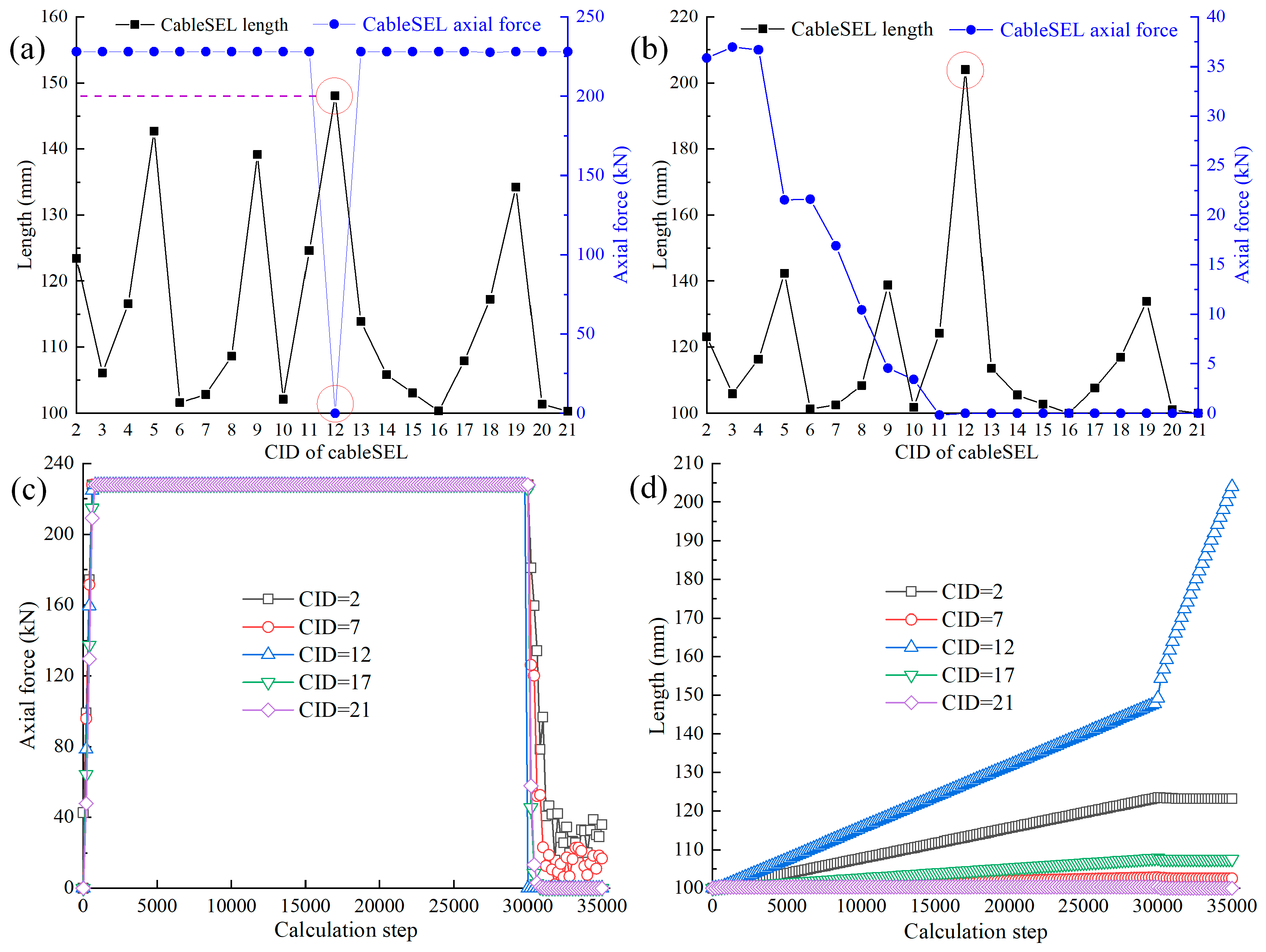



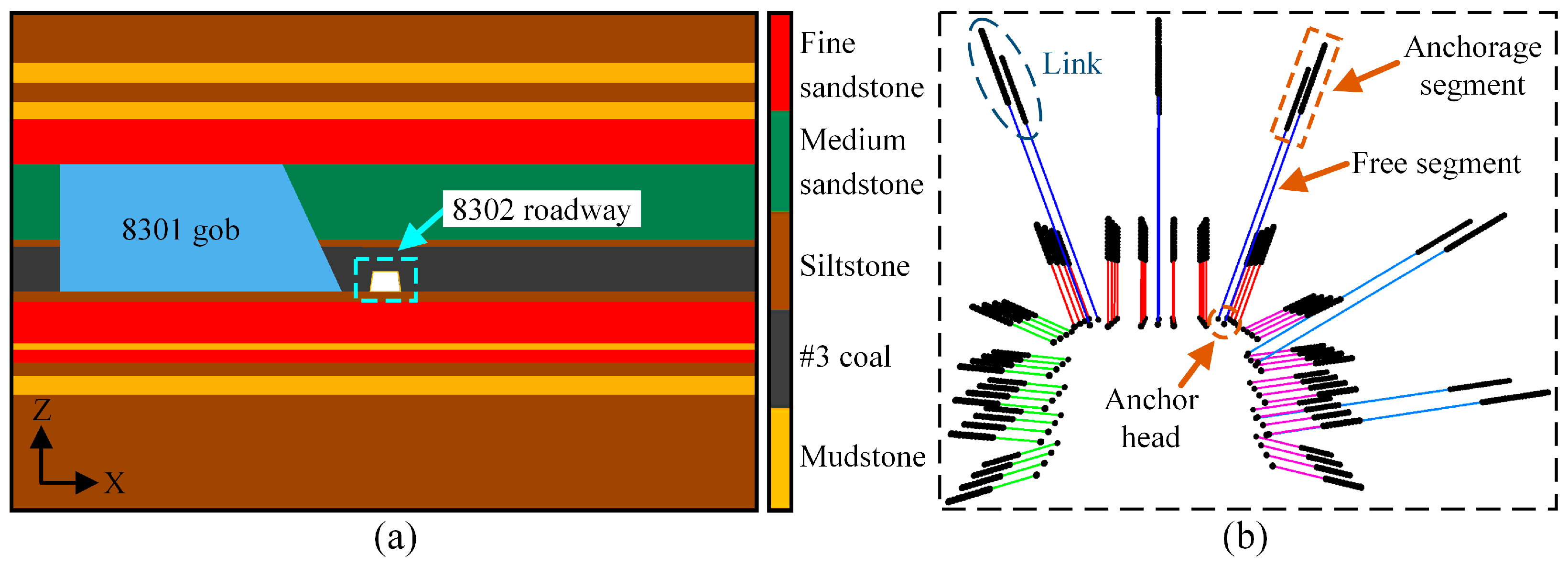

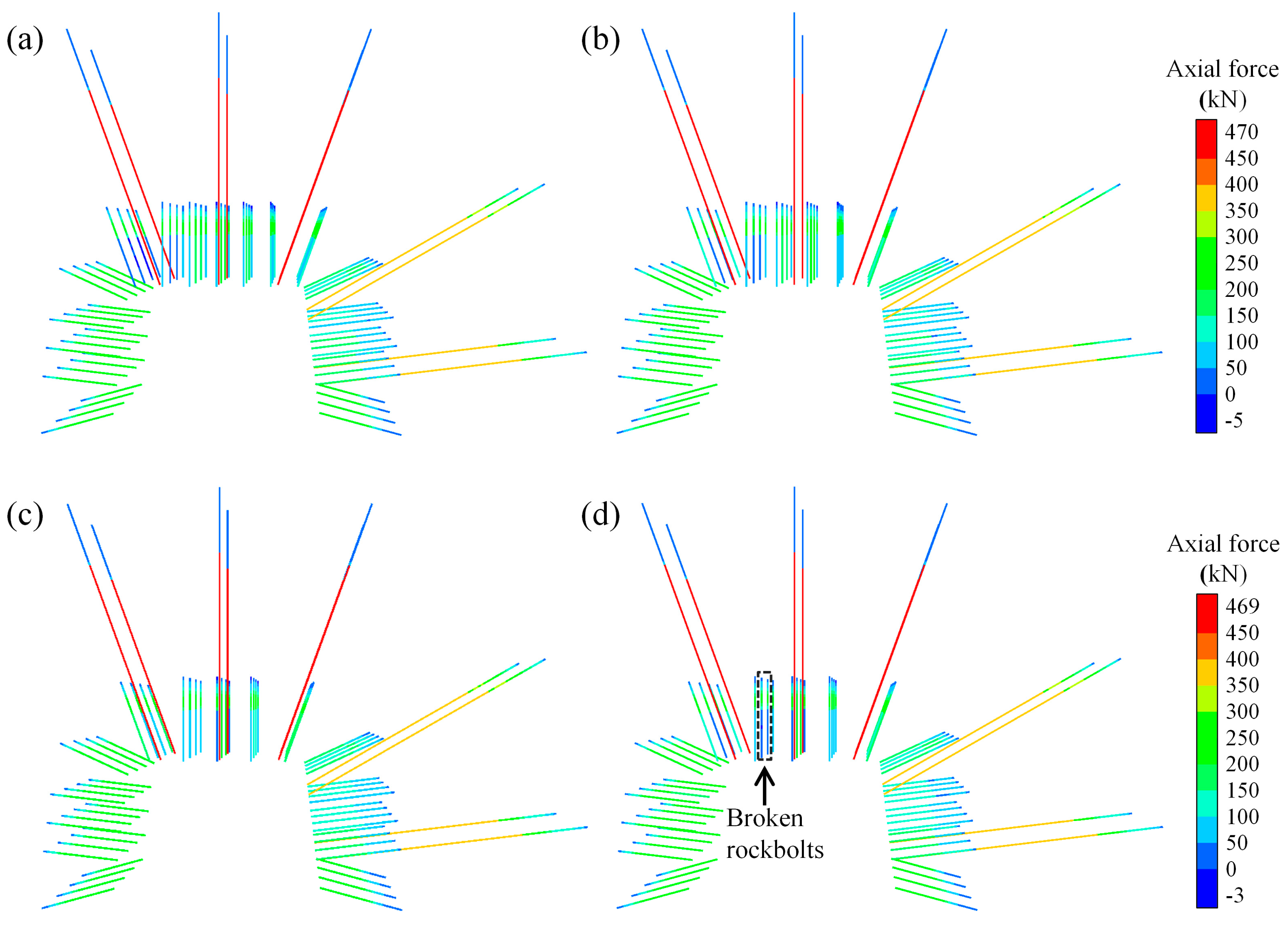
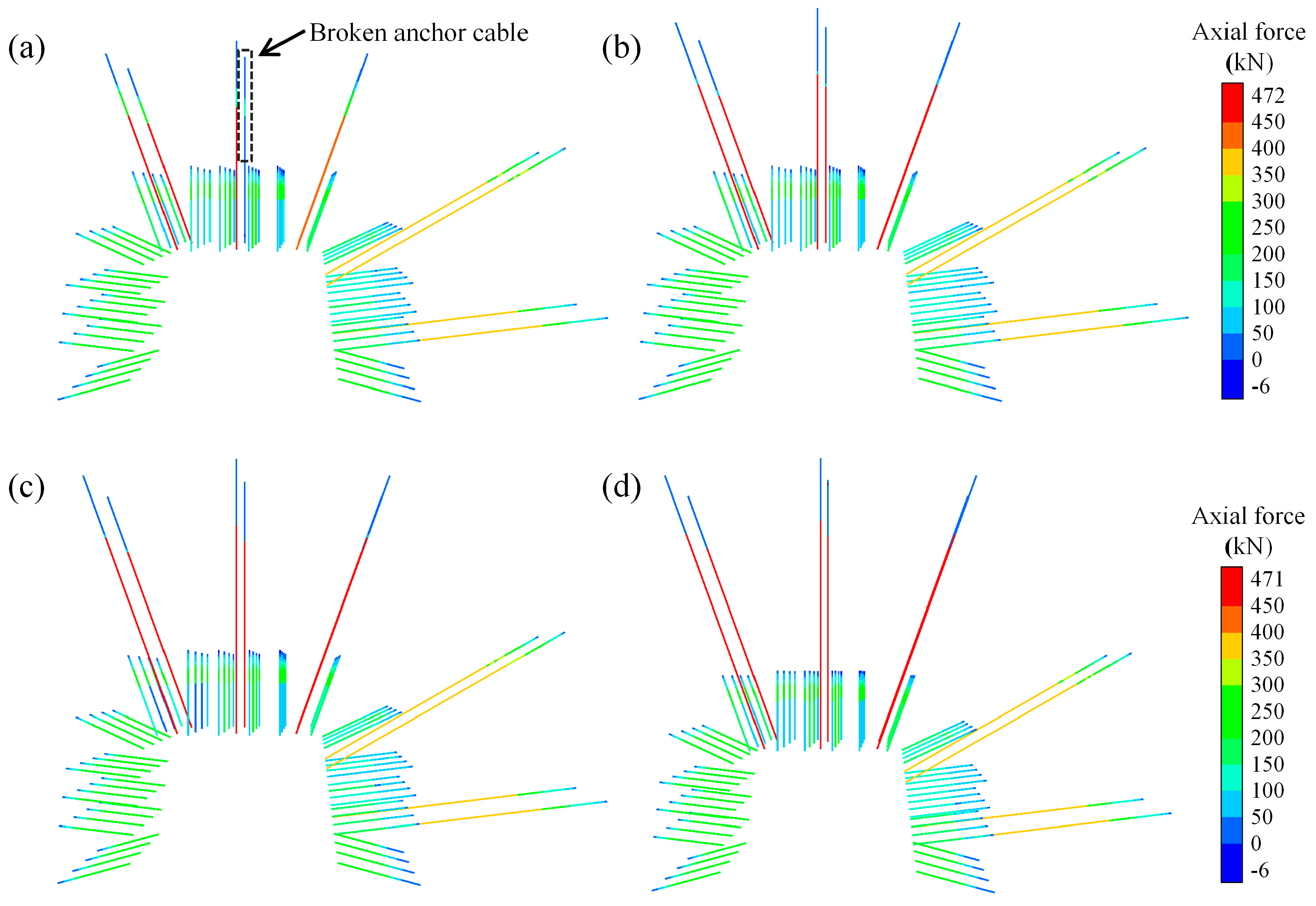
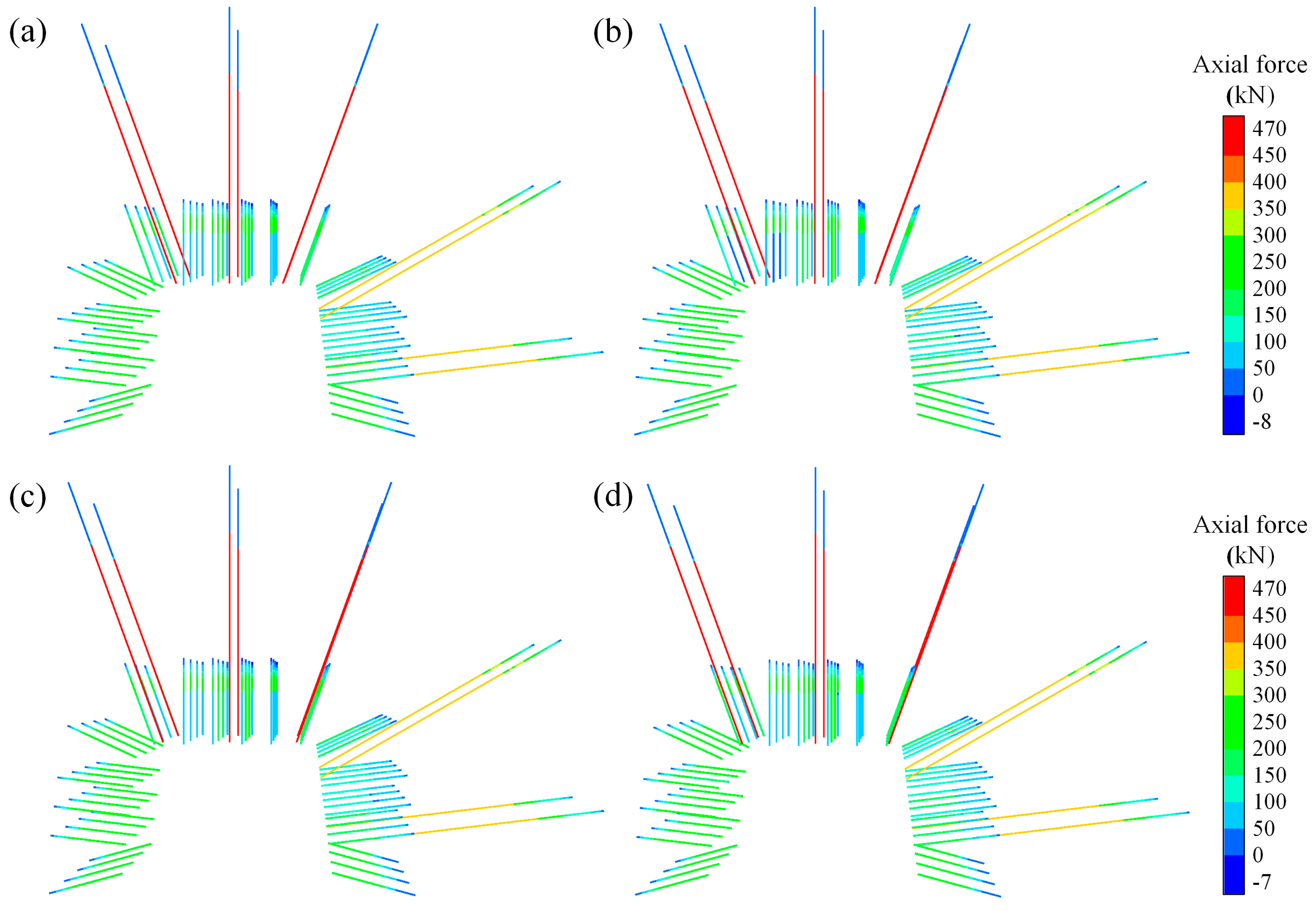
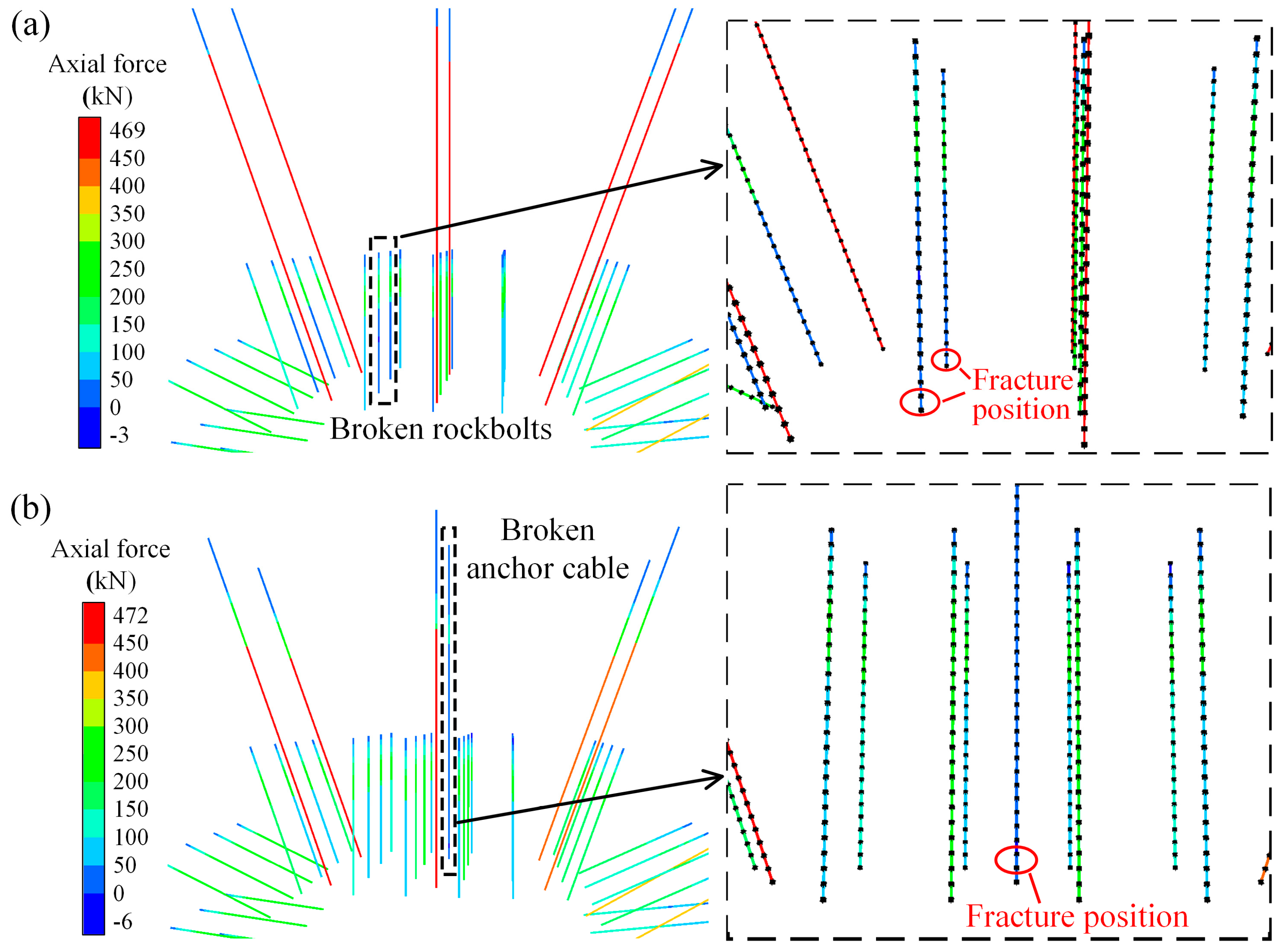

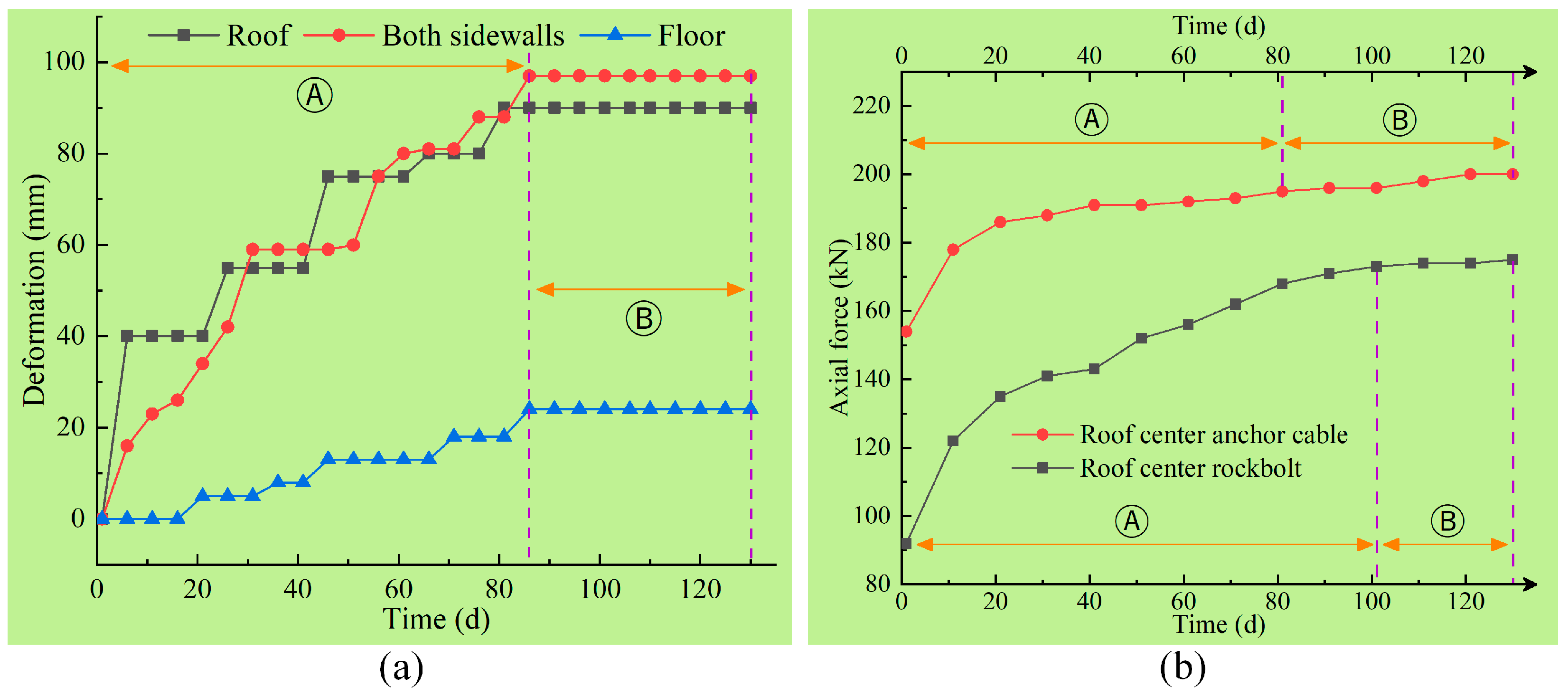

| Medium Sandstone | Fine Sandstone | Siltstone | #3 Coal | Mudstone | |
|---|---|---|---|---|---|
| Poisson’s ratio | 0.28 | 0.18 | 0.27 | 0.28 | 0.20 |
| Density (kg/m3) | 2744 | 2695 | 2626 | 1300 | 2646 |
| Uniaxial compressive strength (MPa) | 122.0 | 105.0 | 45.4 | 9.6 | 23.2 |
| Tensile strength (MPa) | 4.0 | 3.6 | 1.5 | 0.5 | 1.4 |
| Cohesion (MPa) | 12.0 | 11.0 | 3.5 | 1.0 | 4.0 |
| Elastic modulus (GPa) | 30.00 | 26.70 | 10.91 | 1.34 | 6.62 |
| Bulk modulus (GPa) | 22.73 | 13.69 | 7.91 | 1.02 | 3.68 |
| Shear modulus (GPa) | 11.72 | 11.36 | 4.30 | 0.52 | 2.76 |
| Friction angle (°) | 43 | 38 | 35 | 28 | 37 |
| Parameter | Value (m) | |||
|---|---|---|---|---|
| Rockbolt length | 1.9 | 2.2 | 2.5 | 2.8 |
| Rockbolt spacing | 0.8 | 0.9 | 1.0 | 1.1 |
| Anchor cable length | 6.3 | 7.3 | 8.3 | 9.3 |
| Anchor cable spacing | 1.6 | 1.8 | 2.0 | 2.2 |
| Density (kg/m3) | Bulk Modulus (GPa) | Shear Modulus (GPa) | Angle of Dilation (°) | Angle of Internal Friction (°) |
|---|---|---|---|---|
| 1700 | 16.3 | 7.0 | 20 | 30 |
| Support Rod | Cross-Sectional Area (mm2) | Preload (kN) | Yield Axial Force (kN) | Fracture Elongation Ratio (%) | Elastic Modulus (GPa) |
|---|---|---|---|---|---|
| Rockbolt | 380 | 80 | 228 | 15 | 200 |
| Anchor cable | 285 | 200 | 477 | 5 | 195 |
| Rock Strata | Outer Diameter of Grout (mm) | Cohesion (MPa) | Bulk Modulus (MPa) |
|---|---|---|---|
| Coal | 28 | 0.4 | 1.6 × 104 |
| Sandstone | 28 | 2.6 | 1.6 × 104 |
| Roof Rockbolt Length (m) | Displacement (mm) | Total Displacement (mm) | |||
|---|---|---|---|---|---|
| Roof | Coal Pillar Wall | Solid Coal Wall | Floor | ||
| 1.9 | 281.6 | 216.1 | 161.9 | 13.1 | 672.7 |
| 2.2 | 258.8 | 194.2 | 155.6 | 13.0 | 621.6 |
| 2.5 | 247.1 | 190.0 | 152.5 | 13.0 | 602.6 |
| 2.8 | 246.5 | 189.2 | 152.0 | 13.0 | 600.7 |
| Roof Rockbolt Spacing (m) | Displacement (mm) | Total Displacement (mm) | |||
|---|---|---|---|---|---|
| Roof | Coal Pillar Wall | Solid Coal Wall | Floor | ||
| 0.8 | 245.8 | 190.0 | 152.4 | 13.0 | 601.2 |
| 0.9 | 247.1 | 190.0 | 152.5 | 13.0 | 602.6 |
| 1.0 | 267.7 | 196.9 | 156.3 | 13.0 | 633.9 |
| 1.1 | 276.8 | 200.0 | 157.3 | 13.1 | 647.2 |
| Length of the Roof Anchor Cable (m) | Displacement (mm) | Total Displacement (mm) | |||
|---|---|---|---|---|---|
| Roof | Coal Pillar Wall | Solid Coal Wall | Floor | ||
| 6.3 | 281.9 | 215.2 | 160.7 | 13.1 | 670.9 |
| 7.3 | 266.4 | 197.7 | 156.6 | 13.0 | 633.7 |
| 8.3 | 247.1 | 190.0 | 152.5 | 13.0 | 602.6 |
| 9.3 | 258.3 | 192.3 | 155.2 | 13.0 | 618.8 |
| Spacing of Roof Anchor Cables (m) | Displacement (mm) | Total Displacement (mm) | |||
|---|---|---|---|---|---|
| Roof | Coal Pillar Wall | Solid Coal Wall | Floor | ||
| 1.6 | 237.4 | 178.7 | 146.7 | 13.0 | 575.8 |
| 1.8 | 247.1 | 190.0 | 152.5 | 13.0 | 602.6 |
| 2.0 | 257.9 | 191.1 | 154.8 | 13.0 | 616.8 |
| 2.2 | 268.0 | 198.9 | 156.7 | 13.0 | 636.6 |
| Rockbolt Length (m) | Rockbolt Spacing (m) | Anchor Cable Length (m) | Anchor Cable Spacing (m) | |
|---|---|---|---|---|
| Roof | 2.5 | 0.9 × 1.0 | 8.3 | 1.6 × 2.0 |
| Solid coal wall | 2.5 | 0.9 × 1.0 | 8.3 | 2.0 × 2.0 |
| Coal pillar wall | 2.2 | 0.9 × 1.0 | - | - |
Disclaimer/Publisher’s Note: The statements, opinions and data contained in all publications are solely those of the individual author(s) and contributor(s) and not of MDPI and/or the editor(s). MDPI and/or the editor(s) disclaim responsibility for any injury to people or property resulting from any ideas, methods, instructions or products referred to in the content. |
© 2024 by the authors. Licensee MDPI, Basel, Switzerland. This article is an open access article distributed under the terms and conditions of the Creative Commons Attribution (CC BY) license (https://creativecommons.org/licenses/by/4.0/).
Share and Cite
Zhang, W.; Zhao, S.; Zhang, B.; Gao, W.; Zhu, Q.; Li, T.; Wang, B. An Improved Numerical Simulation Method for Rockbolt Fracture and Its Application in Deep Extra-Thick Coal Seam Roadways. Buildings 2024, 14, 2373. https://doi.org/10.3390/buildings14082373
Zhang W, Zhao S, Zhang B, Gao W, Zhu Q, Li T, Wang B. An Improved Numerical Simulation Method for Rockbolt Fracture and Its Application in Deep Extra-Thick Coal Seam Roadways. Buildings. 2024; 14(8):2373. https://doi.org/10.3390/buildings14082373
Chicago/Turabian StyleZhang, Wenhao, Shuang Zhao, Bin Zhang, Weimin Gao, Qingwen Zhu, Tingchun Li, and Binxu Wang. 2024. "An Improved Numerical Simulation Method for Rockbolt Fracture and Its Application in Deep Extra-Thick Coal Seam Roadways" Buildings 14, no. 8: 2373. https://doi.org/10.3390/buildings14082373
APA StyleZhang, W., Zhao, S., Zhang, B., Gao, W., Zhu, Q., Li, T., & Wang, B. (2024). An Improved Numerical Simulation Method for Rockbolt Fracture and Its Application in Deep Extra-Thick Coal Seam Roadways. Buildings, 14(8), 2373. https://doi.org/10.3390/buildings14082373





